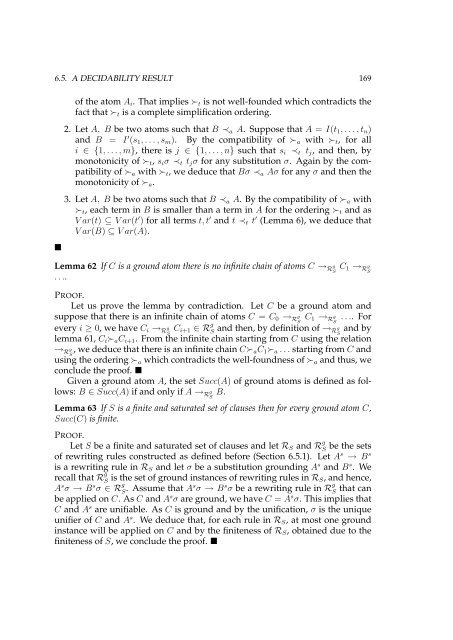Logical Analysis and Verification of Cryptographic Protocols - Loria
Logical Analysis and Verification of Cryptographic Protocols - Loria
Logical Analysis and Verification of Cryptographic Protocols - Loria
You also want an ePaper? Increase the reach of your titles
YUMPU automatically turns print PDFs into web optimized ePapers that Google loves.
6.5. A DECIDABILITY RESULT 169<br />
�<br />
<strong>of</strong> the atom Ai. That implies ≻t is not well-founded which contradicts the<br />
fact that ≻t is a complete simplification ordering.<br />
2. Let A, B be two atoms such that B ≺a A. Suppose that A = I(t1, . . . , tn)<br />
<strong>and</strong> B = I ′ (s1, . . . , sm). By the compatibility <strong>of</strong> ≻a with ≻t, for all<br />
i ∈ {1, . . . , m}, there is j ∈ {1, . . . , n} such that si ≺t tj, <strong>and</strong> then, by<br />
monotonicity <strong>of</strong> ≻t, siσ ≺t tjσ for any substitution σ. Again by the compatibility<br />
<strong>of</strong> ≻a with ≻t, we deduce that Bσ ≺a Aσ for any σ <strong>and</strong> then the<br />
monotonicity <strong>of</strong> ≻a.<br />
3. Let A, B be two atoms such that B ≺a A. By the compatibility <strong>of</strong> ≻a with<br />
≻t, each term in B is smaller than a term in A for the ordering ≻t <strong>and</strong> as<br />
V ar(t) ⊆ V ar(t ′ ) for all terms t, t ′ <strong>and</strong> t ≺t t ′ (Lemma 6), we deduce that<br />
V ar(B) ⊆ V ar(A).<br />
Lemma 62 If C is a ground atom there is no infinite chain <strong>of</strong> atoms C → R g<br />
S C1 → R g<br />
S<br />
. . ..<br />
PROOF.<br />
Let us prove the lemma by contradiction. Let C be a ground atom <strong>and</strong><br />
suppose that there is an infinite chain <strong>of</strong> atoms C = C0 → g<br />
RS C1 → g<br />
R . . .. For<br />
S<br />
every i ≥ 0, we have Ci → g<br />
RS Ci+1 ∈ R g<br />
S <strong>and</strong> then, by definition <strong>of</strong> →R g <strong>and</strong> by<br />
S<br />
lemma 61, Ci≻aCi+1. From the infinite chain starting from C using the relation<br />
→ R g<br />
S , we deduce that there is an infinite chain C≻aC1≻a . . . starting from C <strong>and</strong><br />
using the ordering ≻a which contradicts the well-foundness <strong>of</strong> ≻a <strong>and</strong> thus, we<br />
conclude the pro<strong>of</strong>. �<br />
Given a ground atom A, the set Succ(A) <strong>of</strong> ground atoms is defined as follows:<br />
B ∈ Succ(A) if <strong>and</strong> only if A → R g<br />
S B.<br />
Lemma 63 If S is a finite <strong>and</strong> saturated set <strong>of</strong> clauses then for every ground atom C,<br />
Succ(C) is finite.<br />
PROOF.<br />
Let S be a finite <strong>and</strong> saturated set <strong>of</strong> clauses <strong>and</strong> let RS <strong>and</strong> R g<br />
S be the sets<br />
<strong>of</strong> rewriting rules constructed as defined before (Section 6.5.1). Let As → Bs is a rewriting rule in RS <strong>and</strong> let σ be a substitution grounding A s <strong>and</strong> B s . We<br />
recall that R g<br />
S is the set <strong>of</strong> ground instances <strong>of</strong> rewriting rules in RS, <strong>and</strong> hence,<br />
A s σ → B s σ ∈ R g<br />
S . Assume that As σ → B s σ be a rewriting rule in R g<br />
S<br />
that can<br />
be applied on C. As C <strong>and</strong> A s σ are ground, we have C = A s σ. This implies that<br />
C <strong>and</strong> A s are unifiable. As C is ground <strong>and</strong> by the unification, σ is the unique<br />
unifier <strong>of</strong> C <strong>and</strong> A s . We deduce that, for each rule in RS, at most one ground<br />
instance will be applied on C <strong>and</strong> by the finiteness <strong>of</strong> RS, obtained due to the<br />
finiteness <strong>of</strong> S, we conclude the pro<strong>of</strong>. �
















